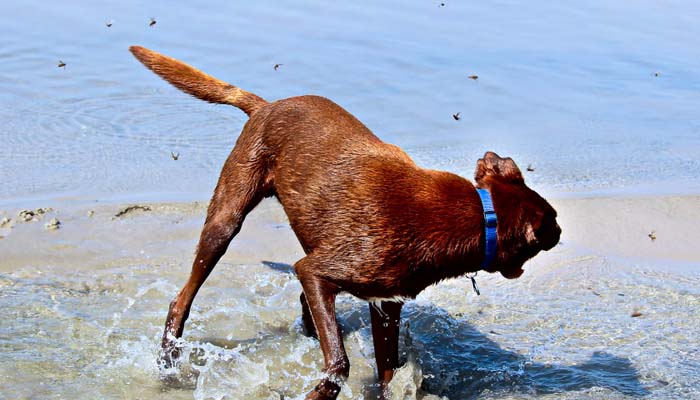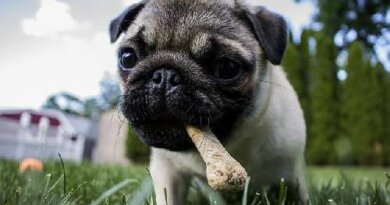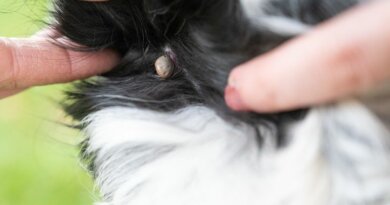Prevention, Signs and Treatments – Top Dog Tips
Flies often seem like very unnoticeable creatures to us, but to our dog they can cause discomfort or even put them in danger.
The difference is that we can successfully defend ourselves from them, while our canine companion often cannot be that effective.
To understand how to protect our dog, we will discuss what fly bites on dogs look like, why flies attack dogs, and what we should do once we recognize them.
Do Flies Bite?
People who live in cities often come across a common house fly, and this fly won’t bite us but just bore us.
However, many other types of flies, found outdoors, in nature, rural areas or farms, do bite.
Who are the most likely culprits?
If you see fly bites on your dog, there’s a good chance it is any of the following bites:
- Horse fly bites
- Stable fly bites
- Mosquito bites
- Black fly bites
- No see ums bites
So, never underestimate these creatures, and be on the lookout for the bite marks on your dog.
Why Do Flies Bite?
Flies are parasitic and attracted by mammals.
The most logical explanation for their bites is feeding off blood and torn skin, but other food or feces particles would also attract them.
Because dogs have warm body temperature and a thick layer of coat, it is also a great spot for creating a nest where flies can lay eggs.
Bear in mind that from their eggs, maggots can appear, which exacerbate the bite wound on your dog.
Even if you clean your dog regularly, he still can pick up dirt and decaying matter from playing and digging into things.
Combine that with the heat emitted by our dog, he or she makes a perfect honey hole for all kinds of biting flies.
RELATED: The Best Fly Repellents for Dogs
Who is the Most Likely Target?
Some dogs are more likely to be attacked by flies. Smaller breeds of dogs are usually safer from this nuisance.
Dogs with upright ears are the most affected breeds.
Also, dogs that spend much time outside are more in danger than those we keep inside our house or a flat.
If your dog is used to being indoors, put screens on your doors and windows to create even safer conditions.
Are Fly Bites Dangerous to Dogs?
Fly bites on dogs can be dangerous.
Not just because of the pain the dog feels after being bitten or the disgust we feel when we think about fly nests on our dog.
Sore places on the skin, like already-created bite marks, open wounds, and scratches, attract flies.
To make things even worse, flies love fecal matter. This is a perfect environment for parasites, bacteria, and disease to be spread.
Then comes our dog running around attracting flies that transmit these illnesses.
A disease-carrying fly biting an open wound causes infection and various health problems.
Remember that even if the wound is very small, it can be infected and worsen.
Your dog’s immune system deteriorates, making fighting other diseases and illnesses more difficult.
How to Recognize Fly Bites on Dogs?
If you see itching redness, especially on your dog’s ears or nose, you can assume it’s a fly bite.
Also, you will probably see him scratching the sore places on his body.
Sometimes a visible bite wound looks like a red dot or bump, similar to the mosquito bite you would see on yourself.
In more serious cases, you can even see blood coming out of the wound or find a small nest of flies.
No see ums fly bites on dogs
These are smaller flies. For the longest time I thought no see ums and gnats were the same thing.
Regardless, these flies are drawn in to suck blood from whatever mammal it lands on. That includes your dog.
Keep an eye out for these annoying pests because their bite can cause a secondary infection if the dog is constantly licking and biting the open wounds.
Black fly bites on dogs
Also known as gnats or buffalo gnats.
Fortunately, these suckers are pretty harmless. These are known to leave a red bullseye mark where they bite.
These flies are found nearby rural wooded areas with flowing streams or small bodies of water.
If your a fly fisherman like myself, you’ll know that these flies among others lay their eggs on the rocks where the larvae will emerge and eventually turn into an adult.
Sometimes these flies can draw blood with their bite.
Horse fly bites
Horse flies are easy to spot. They look like a much bigger house fly. They can grow up to one inch (I’ve seen bigger) in size and have no problem biting more than once.
These bad boys put a hurtin’ on anyone they bite. Despite the pain these flies are for the most part nothing to worry about.
They do have a bite that will break the dog’s skin and cause bleeding.
How to Prevent A Fly Bite?
The best prevention is keeping your dog’s surroundings clean.
It will be more difficult for you if your dog is used to being outside in the hot seasons.
When a swarm of flies is around, keep your dog indoors. If you live in a humid area ripe for mosquitos keep your outdoor dog inside in the evening.
Do your best to prevent flies and mosquitos from coming indoors.
Also, always remember to put away food leftovers and clean his kennel and food bowl more often during summer.
It is not enough to clean your house and yard.
Bathe your dog more often than in other seasons.
Soaps and shampoos with strong smells can chase away insects from your dog.
Plants with strong smells like lavender and rosemary are your friends in this battle. While protecting you and your dog from buzzing creatures, they will also look nice in your house.
Your vet will also have several suggestions about commercial or homemade sprays you can use against flies.
Keep your dog from going to wooded areas. You’re dog
Don’t be ashamed to ask for help.
How to Treat Fly Bites?
As in most cases, prevention is the best cure.
However, if your dog gets bitten anyways, there are some tips and tricks on what to do next.
If there is a rash or redness, treat it with water and soap.
If his ears are the affected parts, you might need to cover them with a cloth to prevent the wound from getting infected or your dog from scratching it and making it worse.
If the bite marks are still there, contact your local vet to be on the safe side.
In some cases, fly bites can lead to more serious infections when the vet removes dead skin from the wound and prescribes the medicine.
Often, the wound will heal on its own since fly bites are usually not too serious.
The important thing is that you protect your dog from future fly attacks, especially if his skin is already sore.
Take your dog inside, at least until his wounds heal.
Summary
Fly bites are not the worst thing that can happen to your dog.
Still, work on prevention by thoroughly cleaning your house and yard to spare your dog unnecessary pain. Be extra careful if your dog spends a lot of time outdoors.
However, if you notice a bite, don’t panic because, in most cases, they cause only temporary discomfort to your dog.
If the redness lasts more than a few days, check this with the vet and follow his instructions on what to do next.
READ NEXT: How to Keep Flies Off Dogs






